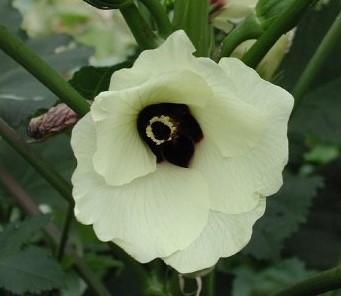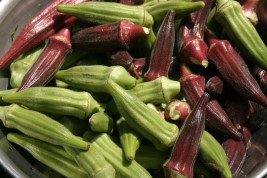
As summer turns to fall and many of the crops in the garden have come to an end, okra plants are just beginning to blossom.
You really aren’t assimilated in the south until you’ve developed a taste for okra.
Many are understandably turned off by its slimy texture, a sticky goo which actually can be utilized to transform New Orleans soups into gumbos.

Okra is often served in cafeterias coated in a batter and deep fried, but okra’s true delicious flavor can be lost when covered in all that greasy dough.
However here’s a simple recipe that lets you avoid all the goo and use it to your advantage.
Harvest when the fruits are 2-3 inches long. Pods larger than 4-5 inches become too tough to eat.
Southern Fried Okra
Slice your okra into pieces of about 1/2 inch and place them in a bowl.
Sprinkle with cornmeal and toss in your bowl until every piece is coated evenly. All the goo gets absorbed and holds the cornmeal in place.
Now transfer the entire bowl to a frying pan with a couple tablespoons of hot oil. We use coconut oil. Because of its ability to withstand high temperatures, it is considered one of the safest oils for cooking. The okra will absorb a lot of the oil, but even though the oil seems to disappear, you won’t have to add much more. Concerned about fat? If you stop eating meat and dairy products, especially cheese, you really don’t have to worry so much about occasionally eating fried foods.

Cover and cook over a low heat stirring occasionally. After about 10 to 15 minutes, the pieces become soft and ready to serve. Yummm!
Freezing for Winter
I make vegetable soups throughout the winter months using vegetables that I froze during the summer. Okra turns my soup into Gumbo and are a great addition to my list of ingredients.
To preserve okra, I follow the standard procedure for freezing vegetables, blanching the pods in stream for about 2-3 minutes, then immersing them in ice water. You have to be careful not to over steam, which will turn your okra into limp, slimy, mush. You want the pods to remain somewhat firm and bright green.
Once I remove the pods from the ice water, I place them on a towel to drip dry and then arrange on a cookie sheet and place on a bottom shelf in my freezer where they will be exposed to the coldest temperatures. After a few hours I gather up the frozen pods and place them in a plastic, zip lock freezer bad for long term storage.
When I am ready to add them to soups, I let the pods thaw out just enough that I can slice them into sections about 1/2 to 3/4 inch long. I usually add several to every batch of soup. MMM Good!



